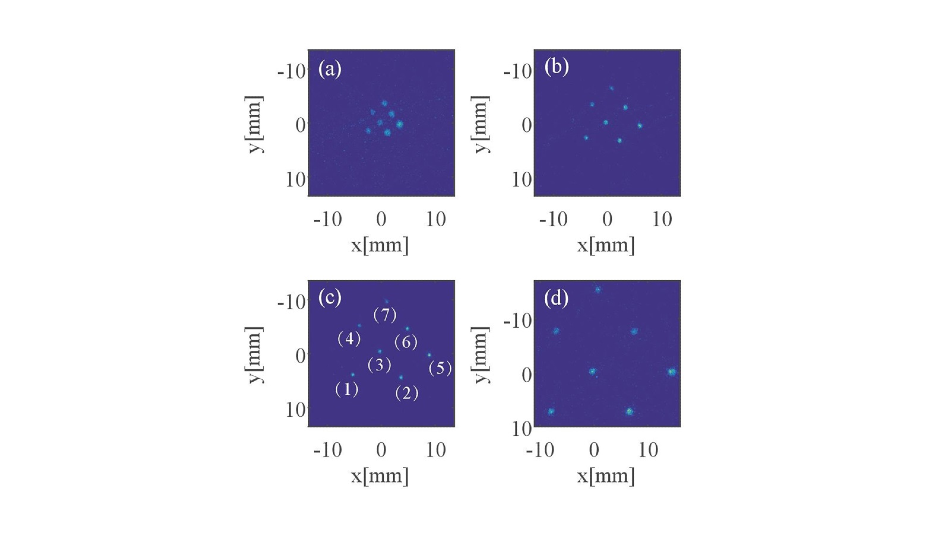Sep 2 2020
The generation of a bright electron beam with unique properties is one of the most crucial challenges faced in an extensive range of high-powered scientific instruments, such as electron microscopes, free-electron lasers, and wakefield accelerators.
 Beam images as a function of solenoid strength. Image Credit: Jiahang Shao / Argonne National Laboratory.
Beam images as a function of solenoid strength. Image Credit: Jiahang Shao / Argonne National Laboratory.
Such instruments can be utilized to examine the properties of matter at the atomic level or to accelerate particles to high energies.
Researchers looking for ways to make the best beams possible are interested in two specific qualities that govern the optimal working of the photocathodes that produce beams—their intrinsic emittance and quantum efficiency.
Quantum efficiency is the measure of the ratio of the number of generated photoelectrons to the photons that hit the cathode. By contrast, intrinsic emittance represents the beam divergence when electrons start emitting.
Researchers show great interest in cathodes that have lower intrinsic emittance and higher quantum efficiency. However, not just that, but they also want the intrinsic emittance and quantum efficiency to be constant throughout the whole cathode.
You can think of our cathode like a TV screen. Our cathode is made up of ‘pixels,’ and like on a TV screen you want each pixel to be of a similar brightness.
Jiahang Shao, Accelerator Physicist, Argonne National Laboratory, U.S. Department of Energy
In the latest study from Argonne, scientists at the Argonne Wakefield Accelerator facility have discovered a new and quicker method to concurrently quantify the distribution of intrinsic emittance and quantum efficiency of a photocathode, and have linked the distributions to gain better insights into the emission mechanism of cesium telluride cathodes, which is a principal type of photocathode.
According to Shao, quantifying the intrinsic emittance of every point on the cathode—going pixel-by-pixel—is a highly time-consuming process. To accelerate things up, the team made use of a device known as a microlens array to make numerous small beamlets that could be quantified at the same time, typically making a pattern rather than performing separate measurements.
The pattern dramatically reduces the time it takes to do our measurements of the entire cathode surface, because instead of having to go step by step we can sample different regions at the same time.
Jiahang Shao, Accelerator Physicist, Argonne National Laboratory, U.S. Department of Energy
To carry out measurements of the emittance of the beamlets, the scientists made use of a device known as a solenoid that focuses the beam on a screen. By adjusting the solenoid’s focusing strength and quantifying the equivalent beam size, scientists can build the emittance of the beam in reverse.
Intrinsic emittance forms a component of the measured total emittance, which includes growth factors due either to impacts caused by the clustering of electrons—known as space charge—or other aberrations caused when the beam propagates.
Researchers attempting to perceive the intrinsic emittance of the cathode itself has must decrease such compounding impacts. As part of this study, such impacts were removed by careful simulation and experiment measures.
Upon investigating the properties of the various beamlets, the scientists observed that beamlets with higher quantum efficiency also tend to have higher intrinsic emittance in general, which makes the efforts to create the best possible beams highly complicated.
It seems that we are always going to have some kind of a trade-off between quantum efficiency and intrinsic emittance. The question is how we balance the two.
Jiahang Shao, Accelerator Physicist, Argonne National Laboratory, U.S. Department of Energy
A paper based on the study, titled “Rapid thermal emittance and quantum efficiency mapping of a cesium telluride cathode in an rf photoinjector using multiple laser beamlets,” was published in Physical Review Accelerators and Beams, on May 4th, 2020.
The other authors of the paper are Argonne’s Lianmin Zheng, Eric Wisniewski, John Power, Wanming Liu, Charles Whiteford, Manoel Conde, Scott Doran, and Chunguang Jing. Yingchao Du and Chuanxiang Tang of China’s Tsinghua University-Beijing also contributed to the study.
The Argonne work was financially supported by DOE’s Office of Science (Office of High Energy Physics).
Journal Reference:
Zheng, L., et al. (2020) Rapid thermal emittance and quantum efficiency mapping of a cesium telluride cathode in an rf photoinjector using multiple laser beamlets. Physical Review Accelerators and Beams. https://doi.org/10.1103/PhysRevAccelBeams.23.052801.